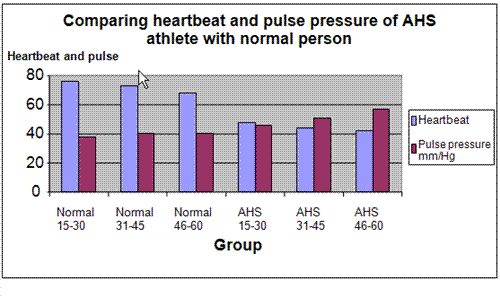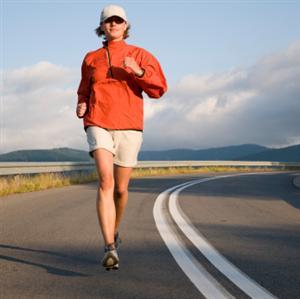| Complexity level: | 7 |
| Project cost ($): | 50 |
| Time required: | 1 day to prepare, 1 day for the science project experiment |
| Material availability: | You will need a portable blood pressure monitor. These are fairly inexpensive and easily available. |
| Safety concerns: | None |
Hypothesis
Athletes with AHS have a higher pulse pressure compared to normal persons, and the pulse pressure increases as they age.
Overview
Athlete Heart Syndrome (AHS)
AHS is a medical condition where the heart of a person becomes enlarged due to prolonged exercise. This condition is common in athletes who train for many hours everyday. Although the condition is harmless, it is difficult to distinguish AHS from other more serious medical conditions.
When an athlete performs prolonged and intensive exercises, the heart will need to pump more blood and oxygen to his muscles. If the exercise is a daily routine, the heart will expand in order to adapt to the requirement for additional oxygen, by becoming enlarged. This will enable the heart to supply more blood and oxygen to the muscles during these periods of high demand. As a result, athletes tend to have lower heart rates during periods of rest.
Another significant reading is pulse pressure. This reading is the difference in blood pressure between systolic and diastolic readings. Normally during exercise, the systolic pressure will increase while the diastolic pressure will remain about the same. This will cause pulse pressure to increase during exercise.
Scientific Terms
Materials
The materials required for this science fair project:
- 10 athletes aged between 15 and 30 years, diagnosed with AHS
- 10 athletes aged between 31 and 45 years, diagnosed with AHS
- 10 athletes aged between 46 and 60 years, diagnosed with AHS
- 10 non-athletes aged between 15 and 30 years
- 10 non-athletes aged between 31 and 45 years
- 10 non-athletes aged between 46 and 60 years
- A blood pressure checking device
Procedure
1. For this science fair project, the independent variable is whether or not the participants have AHS, and the age of the participants. The dependent variable is the pulse pressure of the participants. This is determined by using the blood pressure monitor, to take measurements. The constants (control variables) are the health of the participants and the accuracy of the blood pressure checking device.
2. 60 participants are required for this science project. They are divided into 3 age groups of 15 to 30 years, 31 to 45 years and 46 to 60 years. Each group will have 10 participants who are, or were, athletes and another 10 non-athletes. Other than AHS, all participants must not be having any medical condition like hypertension, heart disease or be on any medications.
3. The participants are brought into the room and made to sit and relax. The participant’s heartbeat rate, systolic blood pressure readings and diastolic blood pressure readings are measured using the blood pressure monitor. The pulse pressure of the participants is obtained by deducting the diastolic pressure from the systolic pressures.
4. The average heartbeat rate and pulse pressure for each group of participants is calculated by totaling the 10 readings and dividing by 10. The calculated values are recorded in the table given below.

Results
It was observed that the participants with AHS (athletes and former athletes) had a lower heart rate but their pulse pressure was higher than the normal (non-athlete) persons. The pulse pressure of the participants also increased with age.
|
Measurement |
Comparing heart rates and pulse pressure of non-athletes and athletes with AHS |
|||||
|
Non-athlete 15-30 |
Non-athlete 31-45 |
Non-athlete 46-60 |
AHS 15-30 |
AHS 31-45 |
AHS 46-60 |
|
|
Heart rate |
76 |
73 |
68 |
48 |
44 |
42 |
|
Pulse pressure mm/Hg |
38.3 |
39.8 |
40.5 |
46.1 |
51.3 |
56.9 |
The chart below represents the results of our science project experiment:

Conclusion
The hypothesis that athletes with AHS have higher pulse pressure compared with normal persons and that their pulse pressure also increases as they grow older is proven to be true.
Recent studies have shown that a high pulse pressure reading increases the risk of heart disease. An increase in pulse pressure of 10mm/Hg can cause the risk of cardiovascular complications to rise by 20%. Pulse pressure can be easily monitored at home using portable blood pressure monitors.
Also consider
What would happen if the science project was repeated comparing the physiological differences between male athletes and female athletes?
The science project experiment can be further enhanced by conducting a survey to compare the occurrence of heart disease among athletes and non-athletes.
References
Athlete heart syndrome - http://en.wikipedia.org/wiki/Athletic_heart_syndrome
Pulse pressure - http://en.wikipedia.org/wiki/Pulse_pressure

